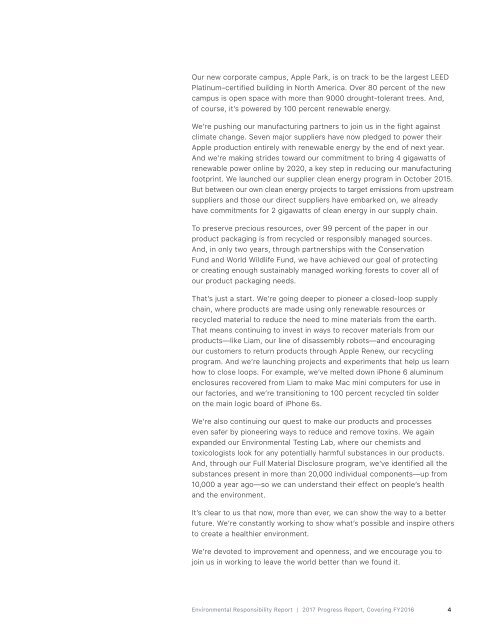Apple Environmental Responsibility Report
You also want an ePaper? Increase the reach of your titles
YUMPU automatically turns print PDFs into web optimized ePapers that Google loves.
Our new corporate campus, <strong>Apple</strong> Park, is on track to be the largest LEED<br />
Platinum–certified building in North America. Over 80 percent of the new<br />
campus is open space with more than 9000 drought-tolerant trees. And,<br />
of course, it’s powered by 100 percent renewable energy.<br />
We’re pushing our manufacturing partners to join us in the fight against<br />
climate change. Seven major suppliers have now pledged to power their<br />
<strong>Apple</strong> production entirely with renewable energy by the end of next year.<br />
And we’re making strides toward our commitment to bring 4 gigawatts of<br />
renewable power online by 2020, a key step in reducing our manufacturing<br />
footprint. We launched our supplier clean energy program in October 2015.<br />
But between our own clean energy projects to target emissions from upstream<br />
suppliers and those our direct suppliers have embarked on, we already<br />
have commitments for 2 gigawatts of clean energy in our supply chain.<br />
To preserve precious resources, over 99 percent of the paper in our<br />
product packaging is from recycled or responsibly managed sources.<br />
And, in only two years, through partnerships with the Conservation<br />
Fund and World Wildlife Fund, we have achieved our goal of protecting<br />
or creating enough sustainably managed working forests to cover all of<br />
our product packaging needs.<br />
That’s just a start. We’re going deeper to pioneer a closed-loop supply<br />
chain, where products are made using only renewable resources or<br />
recycled material to reduce the need to mine materials from the earth.<br />
That means continuing to invest in ways to recover materials from our<br />
products—like Liam, our line of disassembly robots—and encouraging<br />
our customers to return products through <strong>Apple</strong> Renew, our recycling<br />
program. And we’re launching projects and experiments that help us learn<br />
how to close loops. For example, we’ve melted down iPhone 6 aluminum<br />
enclosures recovered from Liam to make Mac mini computers for use in<br />
our factories, and we’re transitioning to 100 percent recycled tin solder<br />
on the main logic board of iPhone 6s.<br />
We’re also continuing our quest to make our products and processes<br />
even safer by pioneering ways to reduce and remove toxins. We again<br />
expanded our <strong>Environmental</strong> Testing Lab, where our chemists and<br />
toxicologists look for any potentially harmful substances in our products.<br />
And, through our Full Material Disclosure program, we’ve identified all the<br />
substances present in more than 20,000 individual components—up from<br />
10,000 a year ago—so we can understand their effect on people’s health<br />
and the environment.<br />
It’s clear to us that now, more than ever, we can show the way to a better<br />
future. We’re constantly working to show what’s possible and inspire others<br />
to create a healthier environment.<br />
We’re devoted to improvement and openness, and we encourage you to<br />
join us in working to leave the world better than we found it.<br />
<strong>Environmental</strong> <strong>Responsibility</strong> <strong>Report</strong> | 2017 Progress <strong>Report</strong>, Covering FY2016<br />
4







